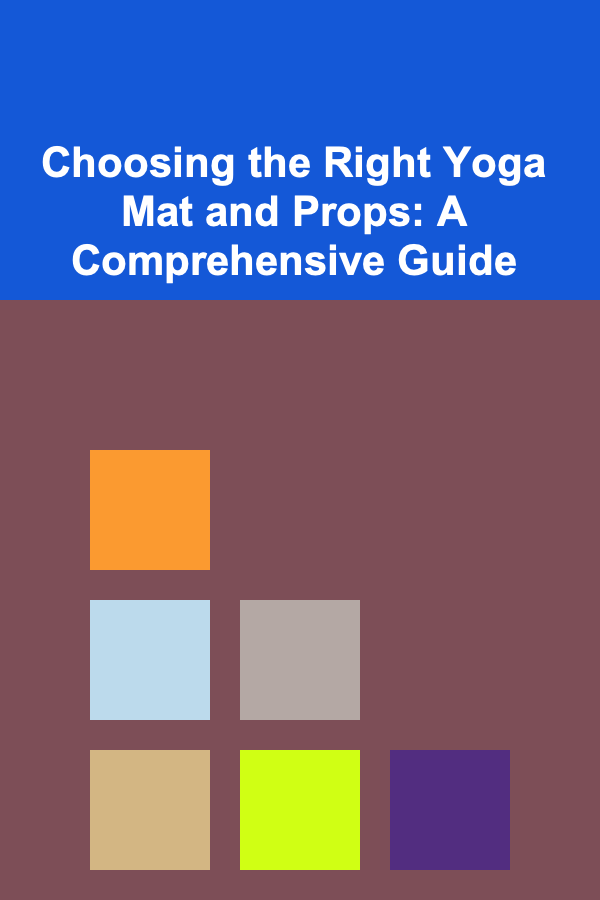
Choosing the Right Yoga Mat and Props: A Comprehensive Guide
ebook include PDF & Audio bundle (Micro Guide)
$12.99$7.99
Limited Time Offer! Order within the next:

Yoga, an ancient practice uniting mind, body, and spirit, has experienced a surge in popularity worldwide. Whether you're a seasoned yogi or a curious beginner, the foundation of your practice often lies in the tools you use. While the essence of yoga transcends material possessions, having the right mat and props can significantly enhance your comfort, stability, and overall experience. This comprehensive guide delves into the intricacies of selecting the perfect yoga mat and props, considering various factors to help you make an informed decision that supports your unique journey.
Part 1: Unveiling the World of Yoga Mats
The yoga mat is arguably the most essential piece of equipment for any yoga practitioner. It provides a dedicated space, offers cushioning and grip, and helps maintain hygiene during practice. However, with a plethora of options available, choosing the right mat can feel overwhelming. Let's break down the key considerations:
1.1 Material Matters: Exploring Yoga Mat Materials
The material of a yoga mat greatly influences its performance, durability, and environmental impact. Here's a look at some common materials:
- PVC (Polyvinyl Chloride): PVC mats are typically the most affordable and widely available. They offer good grip and cushioning, making them suitable for beginners. However, PVC is a synthetic material derived from petroleum and can release harmful chemicals during manufacturing and disposal. It's generally not considered an environmentally friendly option. Look for "phthalate-free" PVC mats to minimize exposure to potentially harmful plasticizers.
- TPE (Thermoplastic Elastomer): TPE is a blend of plastic and rubber polymers, offering a more eco-friendly alternative to PVC. TPE mats are lightweight, recyclable, and often offer good grip and cushioning. They tend to be more expensive than PVC mats but are generally considered a better choice for both personal health and the environment.
- Natural Rubber: Natural rubber mats are made from sustainably harvested rubber trees. They offer excellent grip, cushioning, and durability. Rubber mats are biodegradable and eco-friendly. However, they can have a distinctive rubber smell (which usually fades over time) and may not be suitable for individuals with latex allergies. They also tend to be heavier and more expensive than PVC or TPE mats.
- Cork: Cork mats are made from the bark of cork oak trees, a renewable resource. They offer a unique texture and excellent grip, especially when damp. Cork is naturally antimicrobial and resistant to mold and mildew. Cork mats are generally eco-friendly and durable, but they can be more expensive than other options.
- Jute: Jute mats are made from natural jute fibers, often combined with rubber or other materials for grip and cushioning. Jute is a sustainable and biodegradable material. Jute mats offer a unique texture and natural aesthetic. However, they may not be as durable or offer as much cushioning as other materials.
Tip: If you're sensitive to odors, consider a natural rubber mat and air it out thoroughly before use. Alternatively, opt for a TPE or cork mat, which tend to have minimal odor.
1.2 Thickness: Finding the Right Cushioning
The thickness of your yoga mat determines the amount of cushioning it provides, which is crucial for comfort and joint protection, especially during weight-bearing poses. Here's a general guideline:
- 3mm (1/8 inch): Thin mats are lightweight and portable, making them ideal for travel. However, they offer minimal cushioning and may not be suitable for individuals with sensitive joints or those who prefer a softer surface.
- 4-5mm (3/16 - 1/5 inch): This is a standard thickness that provides a good balance of cushioning and stability. It's a versatile option suitable for most yoga styles and practitioners.
- 6mm (1/4 inch) or thicker: Thicker mats offer maximum cushioning and are ideal for individuals with joint pain or those who prefer a very soft surface. However, they can be less stable in balancing poses and may be bulkier to carry around.
Consider your personal preferences and any joint issues when choosing the thickness of your mat. If you're unsure, a 4-5mm mat is a good starting point.
1.3 Grip: Staying Grounded in Your Practice
Grip is essential for preventing slipping and maintaining stability during yoga poses. The ideal grip depends on the material of the mat, your sweat level, and your personal preferences. Natural rubber and cork mats generally offer the best grip, especially when damp. PVC and TPE mats can be slippery when dry but may improve with use. Consider these factors when evaluating grip:
- Material: As mentioned earlier, natural rubber and cork tend to offer superior grip.
- Surface Texture: Some mats have textured surfaces to enhance grip. Look for mats with raised patterns or non-slip coatings.
- Sweat Level: If you tend to sweat a lot during practice, consider a mat specifically designed for hot yoga or a mat with moisture-wicking properties. You can also use a yoga towel to absorb sweat and improve grip.
1.4 Size: Ensuring Adequate Space
Most yoga mats are around 68 inches long and 24 inches wide. However, if you're taller than average or prefer more space, consider an extra-long or extra-wide mat. Ensure that your mat provides enough room for you to comfortably perform all poses without feeling cramped or restricted.
1.5 Price: Balancing Quality and Budget
Yoga mats range in price from affordable to premium. While it's tempting to opt for the cheapest option, investing in a higher-quality mat can offer better performance, durability, and longevity. Consider your budget and prioritize the features that are most important to you, such as material, thickness, and grip. Read reviews and compare prices from different brands to find the best value for your money.
1.6 Environmental Considerations: Choosing Sustainable Options
As awareness of environmental issues grows, many yogis are seeking eco-friendly options. When choosing a yoga mat, consider the materials used, the manufacturing process, and the mat's recyclability. Look for mats made from sustainable materials such as natural rubber, cork, or jute. Choose mats that are free from harmful chemicals and manufactured using environmentally responsible practices. Dispose of your old mat responsibly by recycling it or donating it to a local yoga studio or community center.
Part 2: Exploring the Benefits of Yoga Props
Yoga props are tools that can assist you in achieving proper alignment, deepening your stretches, and making yoga more accessible and enjoyable, regardless of your experience level. They're not a sign of weakness, but rather a way to modify poses to suit your individual needs and limitations.
2.1 Yoga Blocks: Providing Support and Extension
Yoga blocks are rectangular or square blocks made of foam, wood, or cork. They can be used to:
- Shorten the distance between you and the floor: This is particularly helpful in poses like Triangle Pose (Trikonasana) or Half Moon Pose (Ardha Chandrasana) if you can't comfortably reach the floor.
- Support your body in restorative poses: Blocks can be placed under your hips, back, or head in poses like Supported Bridge Pose (Setu Bandhasana) or Supported Child's Pose (Bālāsana) for added comfort and relaxation.
- Improve alignment: Blocks can help you maintain proper alignment in poses like Warrior II (Virabhadrasana II) by ensuring your hips are properly aligned.
- Deepen stretches: By using a block to support your hand in a forward fold, you can gradually work towards deeper stretches in your hamstrings and back.
When choosing yoga blocks, consider the material, size, and weight. Foam blocks are lightweight and affordable but may not be as supportive as wood or cork blocks. Cork blocks are more durable and eco-friendly, while wood blocks offer the most stability. Choose a size that feels comfortable in your hands and allows you to achieve the desired support and extension.
2.2 Yoga Straps: Enhancing Reach and Flexibility
Yoga straps are long, adjustable straps made of cotton, nylon, or other materials. They can be used to:
- Extend your reach: Straps are helpful in poses like Cow Face Pose (Gomukhasana) or Reclining Hand-to-Big-Toe Pose (Supta Padangusthasana) if you have limited flexibility in your shoulders or hamstrings.
- Improve alignment: Straps can help you maintain proper alignment in poses like Boat Pose (Paripurna Navasana) by keeping your legs parallel.
- Deepen stretches: By using a strap to gently pull your leg closer to your chest in a reclined hamstring stretch, you can gradually increase your flexibility.
- Create space in the body: Straps can be used to create space in your shoulders and chest in poses like Shoulder Stand (Sarvangasana).
When choosing a yoga strap, consider the material, length, and buckle type. Cotton straps are soft and comfortable, while nylon straps are more durable. Choose a length that allows you to comfortably reach your feet or hands in various poses. Buckles can be either D-ring or slide-lock. D-ring buckles are more traditional and allow for precise adjustments, while slide-lock buckles are easier to use and offer a secure hold.
2.3 Yoga Bolsters: Providing Restorative Support
Yoga bolsters are long, cylindrical or rectangular cushions that are used primarily in restorative yoga. They can be used to:
- Support your body in restorative poses: Bolsters can be placed under your back, hips, or legs to create a sense of comfort and relaxation in poses like Supported Reclined Butterfly Pose (Supta Baddha Konasana) or Supported Forward Fold (Paschimottanasana).
- Open the chest and shoulders: Bolsters can be placed lengthwise along your spine to open the chest and shoulders in poses like Supported Backbend.
- Relieve tension in the lower back: Bolsters can be placed under your knees in Savasana (Corpse Pose) to relieve tension in the lower back.
- Promote relaxation and stress relief: Restorative yoga with bolsters can help calm the nervous system, reduce stress, and improve sleep quality.
When choosing a yoga bolster, consider the shape, size, and filling. Cylindrical bolsters are versatile and can be used in a variety of poses. Rectangular bolsters offer more support and stability. Choose a size that feels comfortable and provides adequate support for your body. Bolsters are typically filled with cotton, buckwheat hulls, or synthetic materials. Cotton bolsters are soft and comfortable, while buckwheat bolsters are firmer and provide more support. Synthetic bolsters are lightweight and hypoallergenic.
2.4 Yoga Blankets: Versatile Comfort and Support
Yoga blankets are thick, woven blankets that can be used in a variety of ways to provide comfort, support, and warmth during yoga practice. They can be used to:
- Provide cushioning and support: Folded blankets can be placed under your knees, hips, or head to provide cushioning and support in poses like Child's Pose, Seated Forward Fold, or Savasana.
- Modify poses: Rolled blankets can be used to support your neck in Shoulder Stand or to elevate your hips in Seated Forward Fold.
- Provide warmth: Blankets can be used to cover your body during Savasana to maintain body temperature and promote relaxation.
- Create a comfortable and supportive seat: Folded blankets can be used as a meditation cushion or to elevate your hips in seated poses.
When choosing a yoga blanket, consider the material, size, and weight. Cotton blankets are soft and comfortable, while wool blankets are warmer and more durable. Choose a size that allows you to comfortably fold and use the blanket in various poses. The weight of the blanket can also affect its comfort and stability. Heavier blankets tend to be more supportive, while lighter blankets are more portable.
2.5 Other Useful Props
While blocks, straps, bolsters, and blankets are the most common yoga props, other tools can also enhance your practice:
- Yoga Wheel: A hollow, circular prop that can be used to deepen backbends, improve flexibility, and open the chest and shoulders.
- Meditation Cushion (Zafu): A round or crescent-shaped cushion used to support the hips and spine during meditation.
- Eye Pillow: A small pillow filled with flax seeds or other materials that can be placed over the eyes to block out light and promote relaxation during Savasana.
- Yoga Wedge: A triangular-shaped prop that can be used to elevate the heels in squats or to support the wrists in Downward-Facing Dog.
Part 3: Choosing the Right Props for Your Needs and Practice
The best yoga props for you will depend on your individual needs, experience level, and the type of yoga you practice. Here are some general guidelines:
3.1 For Beginners:
If you're new to yoga, start with the basics: a good quality yoga mat, a set of yoga blocks, and a yoga strap. These props will help you learn proper alignment, modify poses, and build strength and flexibility. Focus on mastering the fundamentals before investing in more specialized props.
3.2 For Experienced Practitioners:
Experienced yogis can benefit from a wider range of props to deepen their practice, explore new variations of poses, and address specific areas of tightness or imbalance. Consider adding a bolster, yoga wheel, or meditation cushion to your collection.
3.3 For Restorative Yoga:
Restorative yoga relies heavily on props to create a supportive and relaxing environment. Invest in a bolster, several blankets, and an eye pillow to fully enjoy the benefits of this practice.
3.4 For Prenatal Yoga:
Prenatal yoga can be greatly enhanced with props to provide support, modify poses, and ensure the safety and comfort of the pregnant body. Blocks, bolsters, blankets, and chairs can be used to adapt poses to accommodate the growing belly and changing center of gravity.
3.5 For Specific Physical Limitations:
If you have any physical limitations, such as joint pain, back pain, or limited flexibility, yoga props can be invaluable. Consult with a qualified yoga teacher or physical therapist to determine which props are most appropriate for your specific needs.
Warning: Always use props under the guidance of a qualified yoga instructor, especially if you have any pre-existing injuries or health conditions. Improper use of props can potentially lead to injury.
Part 4: Caring for Your Yoga Mat and Props
Proper care and maintenance will extend the lifespan of your yoga mat and props and keep them clean and hygienic.
4.1 Cleaning Your Yoga Mat:
- After each use: Wipe down your mat with a damp cloth or a yoga mat cleaner to remove sweat and dirt.
- Deep cleaning: Periodically deep clean your mat with a mild soap and water solution. Rinse thoroughly and air dry.
- Avoid harsh chemicals: Do not use bleach or other harsh chemicals on your mat, as they can damage the material.
- Storage: Store your mat rolled up in a cool, dry place. Avoid storing it in direct sunlight or extreme temperatures.
4.2 Caring for Your Yoga Props:
- Blocks: Wipe down your blocks with a damp cloth or a mild disinfectant after each use.
- Straps: Wash your straps regularly in cold water and air dry.
- Bolsters and Blankets: Spot clean bolsters and blankets as needed. You can also remove the covers and wash them according to the manufacturer's instructions.
- Meditation Cushions: Spot clean meditation cushions as needed. You can also remove the covers and wash them according to the manufacturer's instructions.
Part 5: Conclusion: Cultivating a Supportive Practice
Choosing the right yoga mat and props is an investment in your well-being and your yoga practice. By carefully considering your needs, preferences, and budget, you can create a supportive and enjoyable environment for your practice. Remember that the most important thing is to listen to your body, practice with awareness, and cultivate a sense of gratitude for the gift of yoga.
Ultimately, the perfect yoga mat and props are the ones that help you feel comfortable, stable, and supported on your journey. Don't be afraid to experiment and try different options until you find what works best for you. With the right tools and a mindful approach, you can deepen your practice and experience the transformative benefits of yoga for years to come.

How to Choose Light Colors to Make Your Home Feel Bigger
Read More
How to Maintain Your Home's Gutters and Downspouts
Read More
How to Market Your Homemade Watercolors and Turn Your Hobby into Profit
Read More
How to Renovate Your Home for a More Modern and Sleek Aesthetic
Read More
How to Stage Your Bathroom to Create a Spa-Like Experience
Read More
How to Use Under-Bed Storage for Seasonal Items
Read MoreOther Products

How to Choose Light Colors to Make Your Home Feel Bigger
Read More
How to Maintain Your Home's Gutters and Downspouts
Read More
How to Market Your Homemade Watercolors and Turn Your Hobby into Profit
Read More
How to Renovate Your Home for a More Modern and Sleek Aesthetic
Read More
How to Stage Your Bathroom to Create a Spa-Like Experience
Read More